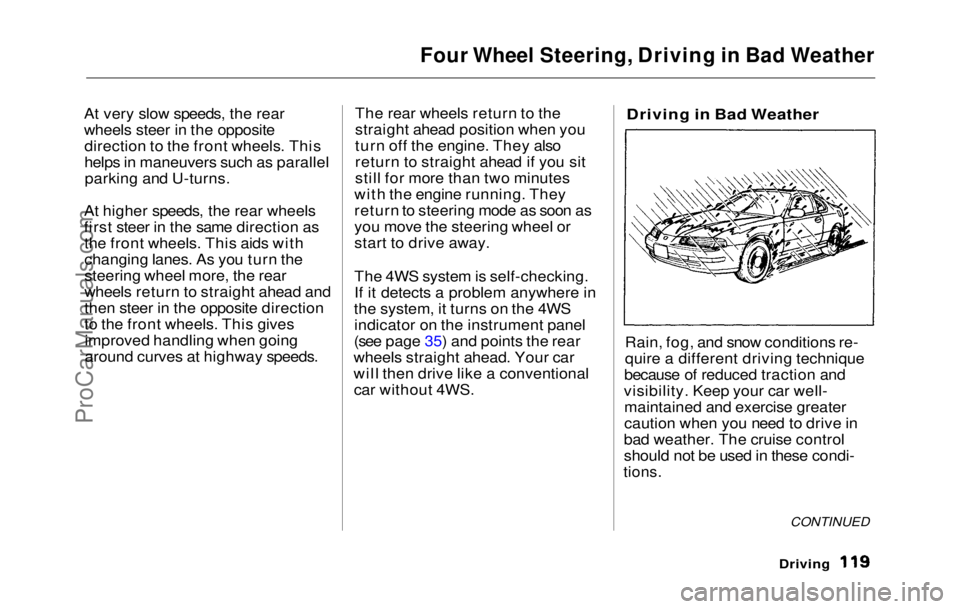Page 118 of 225

Four Wheel Steering, Driving in Bad Weather
At very slow speeds, the rear
wheels steer in the opposite direction to the front wheels. This
helps in maneuvers such as parallelparking and U-turns.
At higher speeds, the rear wheels
first steer in the same direction as the front wheels. This aids with
changing lanes. As you turn the
steering wheel more, the rear
wheels return to straight ahead and
then steer in the opposite direction
to the front wheels. This givesimproved handling when going
around curves at highway speeds. The rear wheels return to the
straight ahead position when you
turn off the engine. They also
return to straight ahead if you sit
still for more than two minutes
with the engine running. They
return to steering mode as soon as
you move the steering wheel or
start to drive away.
The 4WS system is self-checking.
If it detects a problem anywhere in
the system, it turns on the 4WS indicator on the instrument panel
(see page 35) and points the rear
wheels straight ahead. Your car
will then drive like a conventional car without 4WS.
Driving in Bad Weather
Rain, fog, and snow conditions re-
quire a different driving technique
because of reduced traction and
visibility. Keep your car well- maintained and exercise greater
caution when you need to drive in
bad weather. The cruise control
should not be used in these condi-
tions.
CONTINUED
DrivingProCarManuals.comMain Menu Table of Contents s t
Page 192 of 225
Charging System Indication
The charging system light should
go out after the engine starts. If it
comes on brightly with the engine
running, the alternator is no longer
charging the battery. Immediately turn off all electrical
accessories: radio, heater, A/C, rear
defogger, cruise control, etc. Try
not to use other electrically-
operated controls such as the
power windows. Keep the engine
running and take extra care not to
stall it. Starting the engine will discharge the battery rapidly. By eliminating as much of the
electrical load as possible, you can
drive several miles before the
battery is too discharged to keep
the engine running. Drive to a
service station or garage where you
can get technical assistance.
Taking Care of the Unexpected
CHARGING SYSTEM LIGHTProCarManuals.comMain Menu Table of Contents s t
Page 218 of 225

Index
Brightness Control, Instruments................................. 41
Brights, Headlights........................ 40
Bulb Replacement Back-up Lights......................... 169
Brake Lights.............................
169
Front Parking
Lights ..............
165
Front Side
Marker Lights......
166
Headlights................................. 164
High-mount Brake
Light........
168
License Plate
Lights................
171
Rear Sid
e
Marker Lights........
170
Specifications............................ 207
Turn Signa
l
Lights ..................
167
Bulbs, Halogen.............................
.
164
Cables, Jum
p
Starting With........
191
Capacities Chart...........................
206
Carbo
n Monoxide Hazard ............ 25
Cargo, Loading.............................
106
Cassette Playe r
Care..............................................
. 94
Operation.............................. 81,
91
Catalytic Converter.................... .
213
CAUTION, Explanatio
n
of............ ii
Center Console Compartment..... 64
Certification Label....................... 204
Chains............................................. 163
Change Oil
How to........................................ 137
When to...................................... 129
Changing a Flat Tire................... 185
Changing Engine Coolant........... 140
Charging System Light........ 33, 196
Check Engine Light............. 34, 197
Checking
Automatic Transmission
Fluid........................................
144
Battery Condition.................... .
152
Brake Flui
d
...............................
146
Clutch Fluid.............................
.
147
Engine Belts.............................
.
158
Engine Oil.................................
.
135
Fuses........................................... 199
Manual Transmissio
n
Fluid...
145
Power Steerin
g
Fluid..............
148
Radiator Coolant.....................
.
139
Checklist, Befor
e
Driving...........
108
Child Safety....................................
.
18
Cigarette Lighter........................... 65
Cleaner, Air...................................
149
Cleaning
Exterior......................................
176
Interior....................................... 179
Seat Belts...................................
179
Vinyl........................................... 179
CLEAN Light................................
.
94
Clock, Setting the.......................... 63
Clutch Fluid..................................
147
CO i n
the Exhaust........................
211
Cold Weather
,
Starting in...........
110
Compact Spare.............................
.
184
Consumer Information................
217
Controls, Instruments
and............ 29
Coolant
Adding........................................ 139
Checking.................................... 139
Proper Solution......................... 139
Temperature Gauge.................. 38
Corrosion Protection................... 180
Crankcase Emission Control
System........................................ 211
Cruise Control Operation ............. 44
Customer Relations Office......... 217ProCarManuals.comMain Menu s t